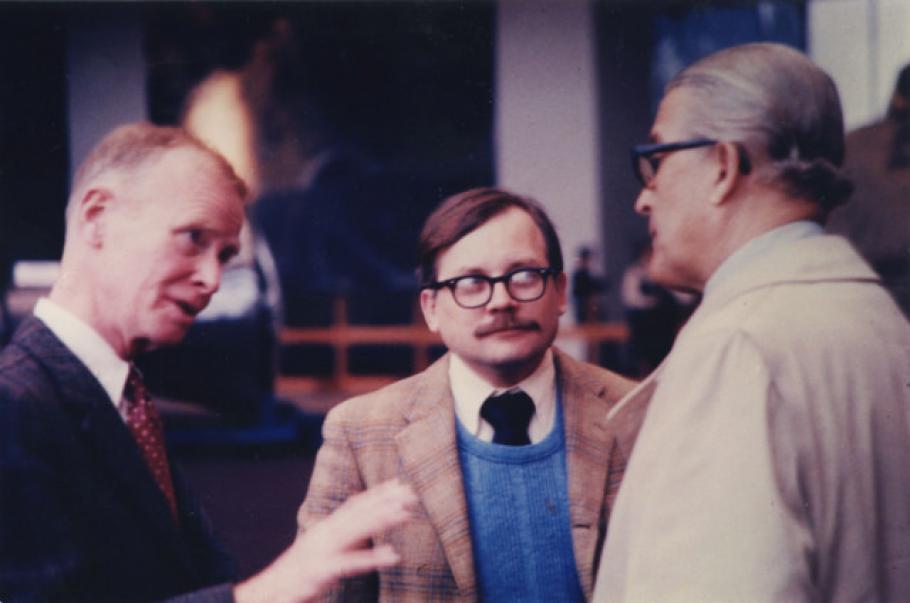From left to right, Fred Durant, the Associate Director for Astronautics, curator Tom Crouch, and Wernher von Braun circa 1975
We have a tradition at the National Air and Space Museum of recognizing the passing of aerospace leaders with a temporary memorial panel displayed for a time on the Museum floor. Once in a while, one of those individuals was not only a figure of some importance in the wider world, but someone of special significance for those of us at the Museum. Such is certainly the case with Fred Durant. I wrote the public memorial panel marking his passing, the text of which is provided below. In this case, however, I wanted to share something a bit more personal. I went to work for Fred on February 2, 1974, when the offices of what was then the Astronautics Department were in the historic red brick Arts and Industries Building. Looking back over more than 41 years, I can say that he was the best boss I ever had. He genuinely cared for those who worked for him and was dedicated to helping them share their passion for the past, present, and future of flight with the public in the most effective and appealing way possible. In 1975-76, when we were busy filling the new building with exhibit galleries that would open to the world on July 1, Wernher von Braun was serving as NASA’s deputy associate administrator for planning, with an office just across Independence Avenue. He would walk over occasionally and call up his old friend Fred Durant, requesting to see some new space display that was approaching completion. On the day the above photo was taken, Fred asked me to show our distinguished visitor one of Robert H. Goddard’s rockets being prepared for display. I treasure this photo as a reminder of a day spent with two men who shaped the early history of the space age.
***
Frederick Clark Durant III Astronautics Authority and Museum Leader 1916–2015
A native of Ardmore, Pennsylvania, and a graduate of Lehigh University, Fred Durant emerged as an authority on rocketry and spaceflight following World War II. After serving as a naval aviator, test pilot, and flight instructor during the war, he entered the field of rocketry while working for Bell Aircraft. He later worked for the U.S. Navy Rocket Test Station, Arthur D. Little, Avco-Everett Research Laboratory, and Bell Aerospace Systems and advised the Central Intelligence Agency on international space and missile programs. Durant played a key role in Project Orbiter, a joint U.S. Navy–Army project to develop a minimum-weight satellite. Explorer 1, the first U.S. satellite, was an outgrowth of that project. Durant was elected president of the American Rocket Society in 1953, helped organize the International Astronautical Federation, and served as its first president. He was a Fellow of the British Interplanetary Society, the German Society for Aviation and Space Flight, the Institute of the Aeronautical Sciences, and the American Institute of Aeronautics and Astronautics. Durant joined the National Air and Space Museum as a consultant in 1964 and became Assistant Director of Astronautics the following year. He led the Museum into the space age and spearheaded the effort to build the world’s finest collection of historic spacecraft and equipment. Under his leadership, the Museum acquired every spacecraft but one in which Americans traveled into space and to the Moon from 1961 to 1972. Thanks to his efforts, the Museum today remains the world’s leading institution for the collection, preservation, study, and display of space artifacts. He also helped build its space art collection and later donated his own collection of space art to the Museum. After his retirement from the Museum in 1980, Durant served as a historian and consultant with Intelsat and continued to write about rocketry and space exploration. He and Ron Miller won the prestigious Hugo Award for their book The Art of Chesley Bonestell. Durant’s circle of lifelong friends included Wernher von Braun and Sir Arthur C. Clarke.
